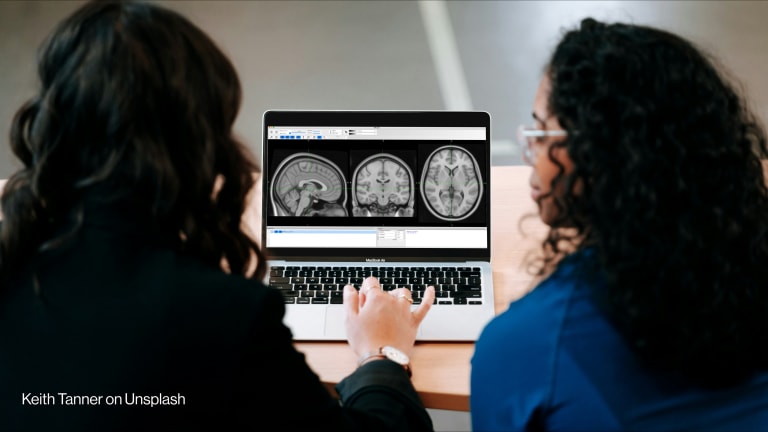
In the three minutes it takes to read this article, almost 100 people will die of a cardiovascular illness such as a heart attack or a stroke.
Visit the HealthTech Dialogue Hub series for more coverage on how to catalyze AI-driven solutions for health and care delivery. You can join the conversation using the hashtag #HealthTech.
Around 18 million people lose their lives to cardiovascular diseases, making it the number one cause of death worldwide. While three-quarters of this burden occurs in low- and middle-income countries, the pandemic led to disruptions in care and many people delayed seeking health care for other conditions, creating a backlog of patients with cardiovascular diseases in many countries around the world.
Technology-enabled solutions now play a fundamental role in providing cardiovascular health services. The term HealthTech includes all technology-powered innovations that are designed to support and enable healthy living.
This year, the Novartis Foundation mapped over 200 HealthTech solutions, revealing some of the greatest opportunities, challenges, and trends that these innovations provide for populations around the world. Here are the five trends the landscape analysis revealed that are here to stay:
1. A selfie can explain a lot about your heart health
Not every cardiovascular HealthTech innovation requires a major learning curve or the use of new devices. Usually the simplest solutions have the fastest adoption and one such example is the Anura mobile app. By self-recording a 30-second video, the artificial intelligence driven solution the app has provides a variety of physiological and psychological metrics including blood pressure, heart rate, stress index, heart rate variability. It indicates whether the person should make changes to their lifestyle or see a physician.
Considering the current shortage of 18 million health workers worldwide, and the increasing health care costs … such technology-powered innovations are bound to grow.
—Other HealthTech solutions that can be implemented easily on a smartphone include automatic tracking and gamifying your daily activities, such as for example with the Healthy Virtuoso app that aims to reward positive, health-reinforcing behaviors.
2. AI can transform cardio diagnostics, also for the disconnected
How the rise of digital tools could help improve cardiovascular health
As the COVID-19 pandemic accelerates the pace of progress for digital health technologies, there is an opportunity for the global health community to close gaps on an individual’s health journey from self-care to service delivery.
The increasing maturity of AI has made intelligent diagnostics a focus area for cardiovascular health. To create such tools, however, a large and diverse set of data is needed to train and validate the models, while ensuring diversity, inclusion, and ethical design.
This means that the data, to be free from bias, has to include sufficient samples from different populations, and oftentimes, the data must be collected through a connected device. The benefit of some of these “data-hungry” algorithms is, however, that once they are created, continuous internet connectivity is not necessary as they can run on the device directly.
Edge AI combines edge computing and AI, allowing algorithms to run on a mobile device or server, rather than in the cloud. This brings great potential for areas where broadband connectivity or smartphone devices are only limitedly available. Examples of such algorithms that don’t need as much data include mobile ultrasound connected devices, portable screening kits, and smart electrocardiogram watches.
3. Cardiovascular HealthTech solutions can help to bridge the last mile
Affordability is one of the challenges for innovative cardiovascular HealthTech. The startup Ilara Health aims to address this by bringing accurate and affordable diagnostics to the 500 million people in Africa who struggle to access a simple blood test. By partnering with a variety of other diagnostic technology providers, Ilara has pioneered a health data platform and service that helps underserved people access primary care services in Kenya.
Considering the current shortage of 18 million health workers worldwide, and the increasing health care costs needed to achieve universal health coverage by 2030, such technology-powered innovations are bound to grow.
4. Successful digital health services combine both people and AI
The HealthTech Dialogue Hub
Driven by a desire to catalyze AI-driven solutions for health and care delivery in LMICs, the HealthTech Hub showcases lessons around technology-enabled innovations, hosts events, and facilitates an ongoing dialogue between government leaders, health workers, and innovators.
From chatbots to AI-powered assistants, tailoring HealthTech solutions to individual needs has become truly important in cardiovascular health.
While many solutions include symptom-checkers or even provide full digital care, there is a trend toward combining both human and digital interventions. Examples include the Glycoleap mobile app and Yumlish personalized digital nutrition platform that offer a mix of digital health services and real-time coaching sessions. These are complemented with mobile dietitians, virtual consultations, and follow-up visits with physicians and nurses, which can happen over platforms.
5. Cardiovascular innovations are becoming more modular, yet more integrated
Many cardiovascular HealthTech innovations are converging toward a flexible architecture that allows them to integrate and exchange data with other systems and solutions more effectively, while also working autonomously. As local contexts vary vastly, the availability of technical standards, governance processes, and related software connectors, is crucial to embed the solutions seamlessly into local health systems without creating costly infrastructure dependencies. Companies such as ToLife and Unite Us for example, are aiming to integrate processes to optimize data-driven decision making.
There is no doubt that cardiovascular HealthTech is here to stay and already has a transformative impact on health systems around the world. Ranging from increasing access and affordability of care to boosting accuracy and speed of diagnostics, decreasing health inequities, and enhancing crisis preparedness and management, HealthTech innovations will become an integral part of individual health journeys and can shift the paradigm of care.
Visit the HealthTech Dialogue Hub series for more coverage on how to catalyze AI-driven solutions for health and care delivery. You can join the conversation using the hashtag #HealthTech.









